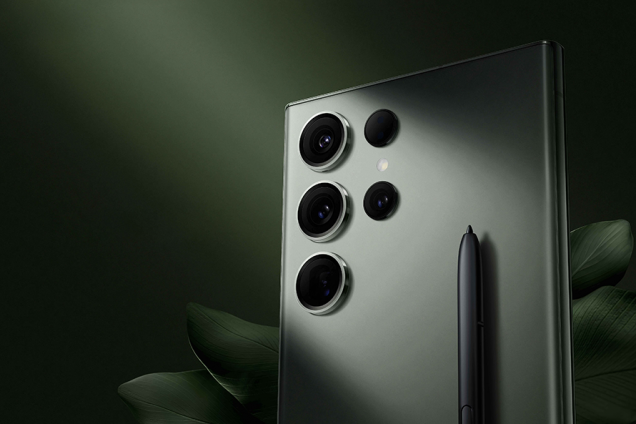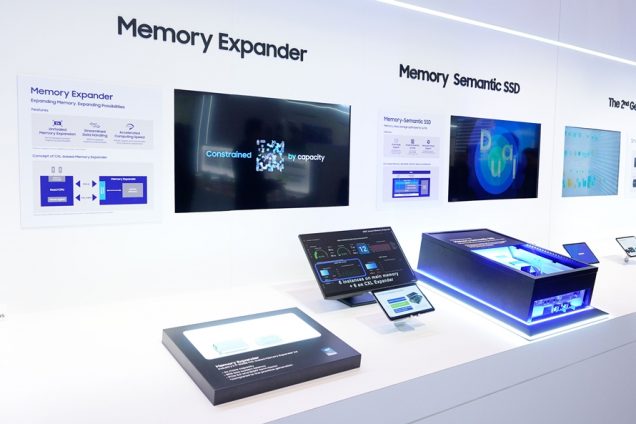[MWC 2023] The Role of Memory in Driving the Development of Cutting-Edge Application Technologies
ChatGPT’s rise into one of the most talked-about topics in the world highlights an ongoing effort to apply cutting-edge application technologies to various fields. These include everything from artificial intelligence (AI) and machine learning (ML) to high-performance computing (HPC). In line with that effort, at this year’s Mobile World Congress (MWC) in Barcelona, Spain, from February 27 to March 2, 2023, Samsung Electronics will offer invited customers a glimpse of the memory products and customized solutions that industries need to take those technologies to the next level.
Because advanced application technologies generally rely on fast and efficient data processing, the role of memory is becoming increasingly crucial. Without memory architectures that are capable of processing and storing sufficient amounts of data, it becomes difficult for advanced technologies to reach their full potential. This can also lead to performance issues and malfunctions, making reliable memory solutions all the more important.
.
[Next-Generation Memory Solutions]

□ Enabling Real-Life Applications for Big Data Processing-Based AI
(HBM3, Memory-Semantic SSD, CXL-Based Memory Expander, SmartSSD)
Artificial intelligence (AI) is a growing field with the potential to revolutionize the way we live, work and play. Memory is an essential part of an AI system’s learning process. It helps the system improve on certain issues and learn from its mistakes by saving and loading information about past experiences.
The ChatGPT chatbot that has made headlines recently is trained to generate language in a similar way to humans. It does so by analyzing vast amounts of text data from books, articles and web pages and learning a wide range of language patterns and structures. That training has made it possible for the chatbot to generate information and deliver it to humans in a conversational manner, as if they were having a chat.
Because conversational AIs like ChatGPT often need to make decisions in real time, it’s recommended that they are paired with high-performance memory that can quickly access necessary information.
This is where Samsung’s cutting-edge HBM3 (high-bandwidth memory) stands out. This high-performance, value-adding technology supports processing speeds of up to 6.4Gbps, with bandwidth reaching 819GBp/s1, by connecting multiple DRAMs vertically. It connects to the CPU or GPU and can help improve server performance during learning and computation.
As AI and AI-related technologies evolve, data generation, storage and processing workloads are expected to increase exponentially. This means that various solutions will be needed to maximize data processing efficiency.
Samsung Electronics continues to lead the development of cutting-edge technologies with one innovative solution after another. These include its Memory-Semantic SSD, which is optimized for AI and ML; a memory expander (CXL) solution that offers up to twice2 the DRAM capacity of existing products; a high-capacity petabyte storage box solution; and a SmartSSD that improves CPU utilization by applying in-house data processing technology.
.
[Mobile]

□ Experiencing Ultimate Immersion Through AR, VR and XR (LPDDR5 uMCP)
AR (augmented reality), VR (virtual reality) and XR (extended reality) are rapidly growing fields that require immense amounts of graphical data to render immersive environments. This typically includes high-resolution images, 3D models and other multimedia content. Processing and storing that data efficiently requires memory with high bandwidth, low latency and fast read/write speeds. The term XR encompasses both AR and VR, which means that various types of memory may be required depending on the use case.
Implementing these immersive technologies requires the combination of memory that can quickly load and process data in real-time with flash memory that retains saved information when power is unavailable. Combining LPDDR5 (low-power DDR) and UFS 3.1 (universal flash storage), LPDDR5 uMCP can be applied for this purpose. By integrating high-performance DRAM and NAND into a single package, it combines fast data processing and storage capabilities in one chip.
□ Supporting Outstanding Photos in Various Conditions (LPDDR5X, UFS 4.0)
Memory plays a crucial role when taking photos at night or filtering images. Images taken at night in low-light conditions require longer exposure times than those taken in daylight. This results in more data being stored in memory. In addition, when filtering photos, large amounts of data need to be manufactured and processed in real-time for both the original and filtered images. This makes memory that enables fast and efficient data processing without latency essential.
LPDDR5X, a premium low-power, high-speed DRAM that offers up to 8.5Gbps data processing and up to 20% greater power efficiency, as well as flash memory like UFS 4.0, which reduces speed bottlenecks with a storage capacity of up to 1TB and offers up to 45% greater battery efficiency and double the speed of its predecessor, can also provide an elevated photography experience.
Products like these enable fast and smooth photography in various conditions and support a wide range of creative activities.
.
[PC/GFX]

□ Providing More Efficient and Immersive PC Experiences (PM9C1a, GDDR6)
For portable devices such as ultrabooks and tablets, memory that combines a compact form factor with high power efficiency and fast data transfers is crucial to ensuring optimal performance. The smaller the form factor, the easier it is to make the device itself more compact and portable. What’s more, as portable devices tend to rely on batteries, power-efficient memory can reduce power consumption and improve battery life.
Samsung’s PM9C1a and GDDR6 are optimized to support more immersive device experiences with greater efficiency and ease.
The PM9C1a is a high-performance SSD that offers drastically improved PC efficiency. In addition to providing sequential read speeds of up to 6,000MB/s and sequential write speeds of up to 5,600MB/s, it offers up to 70% more power efficiency per watt than its predecessor3 and comes in three sizes of the M.2 form factor, offering more options to efficiently manage space in devices. Moreover, memory with fast data transmission speeds supports more efficient multitasking.
In this regard, the GDDR6 is also worth considering. With its industry-leading performance and more powerful bandwidth, the GDDR6 is at the forefront of innovation in HPC and graphics. With support for up to 16Gb of storage and reaching speeds of up to 24Gbps, the GDDR5 not only supports a more advanced and immersive PC and laptop gaming experience, but also enables expert workstations to unleash their creativity and run even more applications, expanding the range of possibilities.
.
[Automotive Solutions]

□ Guaranteeing Safety for Dynamic Road Conditions
As autonomous driving (AD) technologies continue to advance and gain more attention than ever, the role of memory solutions is becoming increasingly more important. In-vehicle memory plays a significant role in enabling vehicles to make informed, data-based decisions by adapting to new situations and applying past experience. It helps the vehicle collect and store vast amounts of data on the driving environment, including the locations of other vehicles, road conditions and weather. It can also draw from past experience to suggest optimal driving routes based on how it reacted to vehicles approaching or handled bad weather conditions in previous scenarios. Simply put, AD is a field that is directly related to safety and to providing a better driving experience. Going forward, the technology’s ability to perform in various, even extreme conditions, as well as its reliability, will be key determinants of success.
Samsung’s AM991 has obtained a Grade 2 certification from AEC-Q1004 and guarantees stable performance in a wide temperature range of 40°C to 105°C. It is an optimal solution for meeting the needs of advanced driver assistance systems (ADAS), AD and in-vehicle infotainment (IVI) alike. Samsung’s journey in mobility innovation continues to evolve with a diverse product portfolio that supports a wide array of mobility-related applications. This includes solutions like the AutoSSD, Auto LPDDR5X, Auto UFS and Auto GGDR6.
From AI to extended reality, to autonomous driving and beyond, Samsung Electronics’ memory solutions are helping cutting-edge application technologies reach their full potential. They do so by maximizing performance and optimizing the user experience with even greater speeds, efficiency, immersion and safety. Samsung looks forward to seeing the new wave of technological advancements and lifestyle changes that its next-generation memory solutions will enable.
.
1 Source: Samsung Datasheet.
2 Up to 8TB per CPU for existing products; Up to 16TB per CPU for the memory expander (CXL) solution. Maximum capacity may vary depending on the system environment.
3 The PM9B1.
4 AEC-Q100 (Automotive Electronic Council): International reliability test and quality standards issued by the Automotive Electronic Council for regulating the reliability evaluation procedure for electronic parts, such as semiconductors, in automobiles.
.
.

Related tag
Related Stories
-
 2023.03.15Introducing ISOCELL HP2: Experience More Pictures and Epic Details on the Galaxy S23 Ultra
2023.03.15Introducing ISOCELL HP2: Experience More Pictures and Epic Details on the Galaxy S23 Ultra -
 2023.02.14The debut of the ISOCELL HP2 with the Galaxy S23 Ultra
2023.02.14The debut of the ISOCELL HP2 with the Galaxy S23 Ultra -
 2023.01.06CES 2023: Samsung Electronics Showcases Cutting-edge Memory Semiconductor Solutions Set to Shape the Fourth Industrial Revolution
2023.01.06CES 2023: Samsung Electronics Showcases Cutting-edge Memory Semiconductor Solutions Set to Shape the Fourth Industrial Revolution